Standing on a thick pad at Brooklyn Boulders climbing gym, Juan Guardiola (pictured above) stares at the wall in front of him, which is dotted with big, knobby holds for hands and feet. He tries to talk himself up for his first-ever attempt to get to the top of a bouldering route. But he’s stuck playing out worst-case fall scenarios because unlike in standard rock climbing, there are no ropes or harnesses in bouldering. He goes for it, reaching with his hands and pushing with his feet, as he moves up from hold to hold. In a matter of seconds, he’s 15 feet up, his arms and legs quivering, and he braces his core to help stick to the wall. He takes a deep breath and spiders his left leg up to the next hold. He pushes through the left leg while reaching one hand to the highest hold. He pulls off the route’s final and most complicated move. He’s at the top.
That’s the beauty of bouldering: It’s just you versus the wall. Each route, aptly called a problem, demands power and precision. Most involve making just five to ten moves along walls that top out around 15 or 20 feet. Speed is a factor because your muscles fatigue as you pull and push your body up the wall, so the faster you go, the better you’re able to make it to the top without your muscles giving out. If they do, or you miss a hold, or your feet lose traction, you fall onto a crash mat. Serious injuries are rare, and the damage is mostly to your ego. Then you start climbing again.
Guardiola climbed again. And again. “I loved the physical and mental challenge, the speed, and how you could fail and do it over and over until you succeeded,” he says. It’s now five years after that initial climb, and Guardiola, 30, is a professional climber and route setter at the brand-new branch of Brooklyn Boulders in Lincoln Park in Chicago. Guardiola spends hours each week creating the intricate patterns of colored holds on the gym’s walls, giving people an opportunity to take their physical and mental strength to the next level.
Why bouldering is so popular right now
Climbing in general has become more popular in recent years, thanks in part to documentaries like Free Solo and The Dawn Wall. These put the sport in the spotlight and started many would-be wall-scalers on the path to top-rope climbing, the style in which a rope runs from a person at the bottom of the route through an anchor at the top and back down to the climber.
The popularity benefited bouldering as well, because the sport is like a gateway to climbing—it’s easier to start, and you don’t need a harness, rope skills, or partner, yet it’s supremely challenging.
“Rope climbing is like running a marathon, and bouldering is a 100-meter dash,” Guardiola says. Each move, from hold to hold, tests you in different ways, allowing a single bouldering problem to pack all the challenges of a two-minute rope climb into 15 to 30 seconds and taxing your energy systems the way high-intensity interval training does. It does all of that in a high-stakes, no-ropes sitch—meaning you need to be focused and creative.

Gyms are fueling the interest. Among the 61 climbing facilities set to open through 2021, the majority will feature bouldering, according to the Climbing Business Journal. The combination of strength, agility, and mobility—not to mention proprioception, your sense of where and how your body is moving—makes bouldering a great functional training method for both life and sports off the wall. Training for a triathlon? Working toward a new deadlift PR? Just want to move easier and without pain? Bouldering can help you get there.
Bouldering lets you work your natural advantage
At BKB Lincoln Park, climbers range in age from five to 75-plus. Some are lean and chiseled; some are thicker and softer. That’s another beauty of bouldering: You can be a success at it with any body type. Every physical quality comes with both some benefits and some difficulties. For instance, while Guardiola’s long arms and five-eleven frame let him grab faraway holds with ease, they don’t let him contort into the small, scrunched-up moves his shorter friends can do. Guys with good balance make “slabs”—bouldering talk for walls that angle at less than 90 degrees—look easy, while people with great upper-body and grip strength have an advantage on overhangs.
“The beauty is that everyone has the same problem in front of them, and how they solve it is unique to their body,” Guardiola says. And no matter your body type, you can expect some clear-cut changes to it when you grab hold of bouldering. The most noticeable: total-body muscle.
Many newbies assume bouldering is just a series of pullups, but good, efficient form requires leading with your legs, so it’s a glute, quad, and hamstring workout, too. You raise your foot to a hold, push through, and, as you step up, grab the next hold with an outstretched arm. This arm-leg connection is key to bouldering’s core-strengthening skills. After all, your core is the link that connects the two parts of your body and helps you transfer force throughout it.
Bouldering is about more than just muscling through: It’s about grit and mental dexterity, too, which is why it’s often called a cerebral sport. “Before each attempt, you look at the start, the end, and map out the order you will move your limbs,” Guardiola says. It’s an act done with mindfulness, and that mental focus becomes even more critical once your feet leave the floor. “You can’t ever think of anything else,” he says. “You have to be there, present on the wall.” When you do fall? You analyze and consider the facts, without judgment, and try again. “Even if I solved the problem, I ask how I could have made it easier on myself,” he adds.
“Bouldering has sent my patience and ability to manage stress through the roof. It teaches me how to stay above my fear—to evaluate the risks but still perform enough to accomplish the tasks I’m doing,” Guardiola says. At least most of the time. He still gets scared of heights occasionally. You never totally get over it, he says. You simply learn how to feel fear and still focus.
The first step: Climb a few feet up the wall, he says. Then let go.
How to train for bouldering – and how to fall well
Bouldering builds a blend of strength and mobility, but it also demands it. Climb easier with these moves from Guardiola’s training arsenal. Add them to your regular program twice a week.
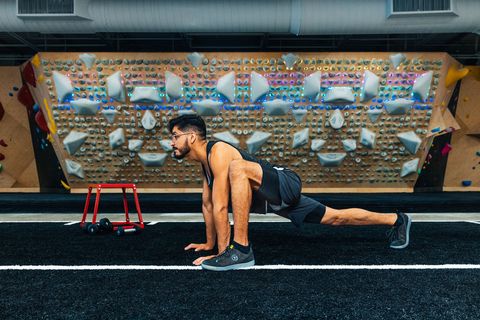
1. Lizard Pose
Do four 15-second holds per side.
Training your hip flexibility increases how easily you can reach faraway footholds. Being able to reach more options gives you more ways to solve any given bouldering problem.
How to do it: In a lunge position, place both palms on the floor on the inside of your lead foot. Slowly lower your hips toward the floor, straightening your back knee. To deepen the stretch, lower your forearms to the floor.
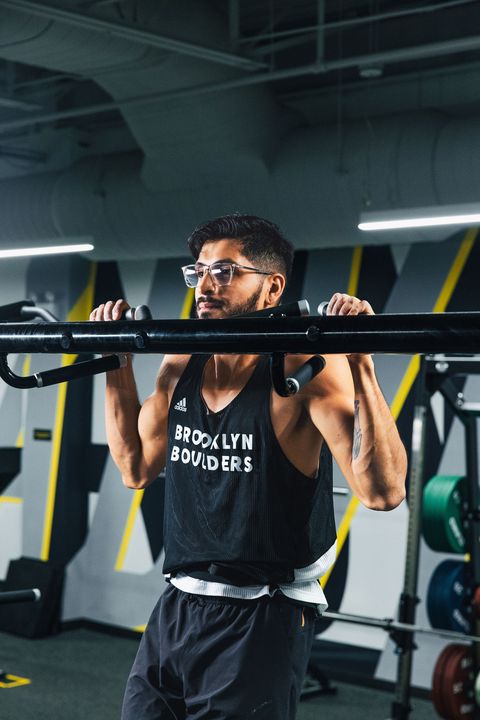
2. Tempo PullUp
Do 6 sets of 2 reps, working up to 3 sets of 6 to 8 reps. Rest for 1 minute between sets.
You don’t have to be able to do pullups to crush a bouldering wall, but it helps. These require a lot of grip, back, and core strength, which will serve you well on any wall.
How to do it: Grab a pullup bar with an overhand grip, hands shoulder-width apart. Squeeze your shoulder blades down and together, brace your core, then raise your feet off the floor. Explosively pull through your back and drive your elbows down along your sides to raise your collarbones to the bar. Pause, then slowly lower over a count of 5.
If you can’t do a pullup (yet), jump up to the bar to start. Then slowly lower yourself down. Release and repeat.
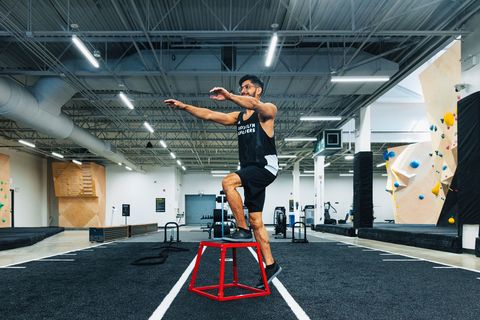
3. High Box Step
Do 4 sets of 8 reps per leg.
This works on lower-body mobility so you can stretch your legs farther apart on the wall.
How to do it: Face a sturdy box that’s knee height or higher. Place one foot on top; transfer your weight to that leg. Explosively drive through your lead foot to straighten your leg and raise to standing. Pause, then slowly lower your trailing foot.
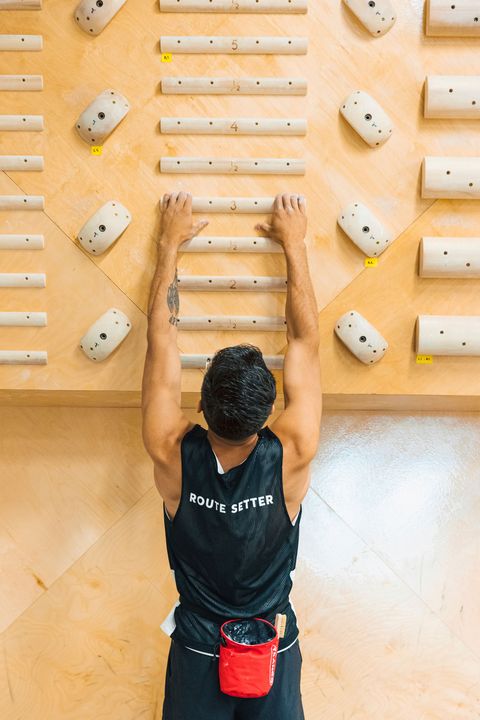
4. Dead Hang
Do 3 sets of four 10-second hangs, resting 1 minute between hangs and 2 to 5 minutes between sets. Bouldering needs more than grip strength; it needs finger strength. This foundational bouldering exercise strengthens your fingers and forearms while also building shoulder stability. It can be done on a campus board, as shown here, or a hangboard, which tends to have holes for your fingers to fit in.
How to do it: Using an open-hand grip, grab same-height holds on the board, using your four fingers without your thumb. Squeeze your shoulder blades down and together, brace your core, then raise your feet off the floor just in front of you. Keep your entire body tight and your shoulders away from your ears.
Most climbing gyms have hangboards or campus boards, but you can do these on monkey or pullup bars. Hang from the bar with your four fingers; don’t use your thumb or wrap it under the bar. (Check out more ways to train your grip for climbing here.)
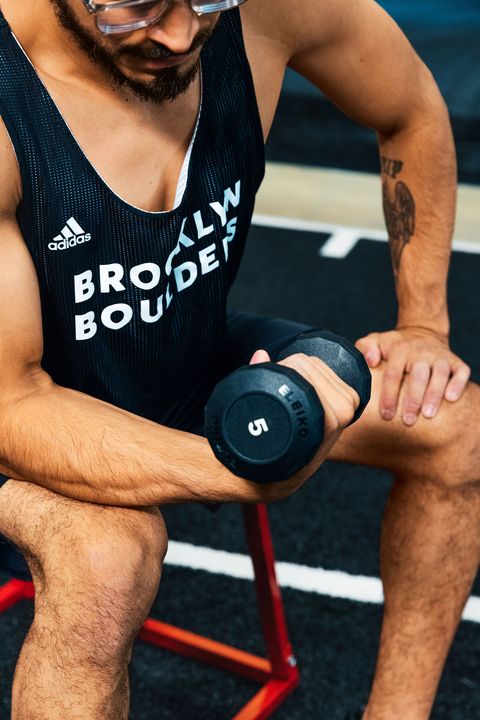
5. Wrist Curl and Extension
Do 3 sets of 12 to 15 reps with each arm.
This move seems small but has big benefits. It strengthens the muscles on both sides of your forearms, ones that control your fingers.
How to do it: Sit down and rest the back of your forearm on your thighs. Hold a light dumbbell in your hand. Let your wrist hang down over the edge of your knees. Relax your fingers so the weight rests close to your fingertips. Slowly curl your fingers over the handles, then roll through your wrists to raise your palm as close as possible to your forearms. Pause, then slowly lower.
Do all reps, then flip your forearm so your palm is down, hanging over your knee. Grip the dumbbell in your hand, and raise the back of your hand as close as possible to your forearm. Pause, then slowly lower.
How to fall well
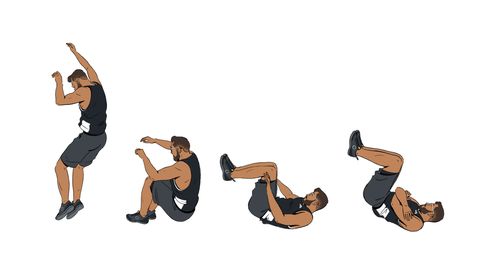
Though it’s ideal to climb down a problem, sometimes you fall. So before you try bouldering, you have to knowhow to fall so you don’t break the fall with your arm (and break your arm). Follow these steps: Land on your feet, bend your knees, roll onto your back, and tuck your arms into your body and your chin into your chest.
This story originally appeared in the September 2021 issue of Men’s Health.
Source: Read Full Article
